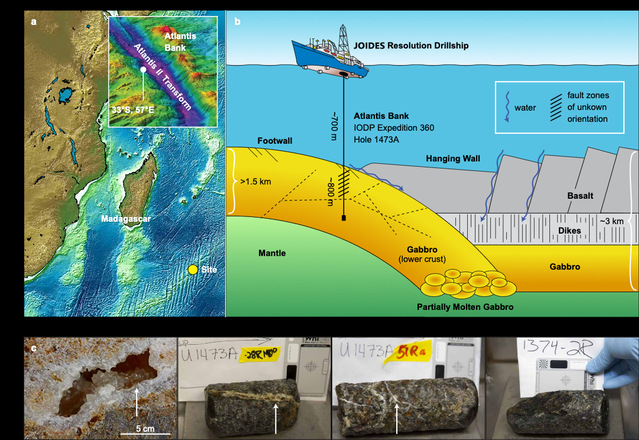Jiangtao Li1,2,9, Paraskevi Mara2,9, Florence Schubotz3,4, Jason B. Sylvan5, Gaëtan Burgaud6, Frieder Klein7, David Beaudoin2, Shu Ying Wee5, Henry J. B. Dick2, Sarah Lott2, Rebecca Cox2, Lara A. E. Meyer3,4, Maxence Quémener6, Donna K. Blackman8 & Virginia P. Edgcomb2,9 *
1 State Key Laboratory of Marine Geology, Tongji University, Shanghai, China.
2 Department of Geology and Geophysics, Woods Hole Oceanographic Institution, Woods Hole, MA, USA.
3 MARUM, University of Bremen, Bremen, Germany.
4 Department of Geosciences, University of Bremen, Bremen, Germany.
5 Department of Oceanography, Texas A&M University, College Station, TX, USA.
6 Université de Brest, EA 3882, Laboratoire Universitaire de Biodiversité et Ecologie Microbienne, ESIAB, Technopôle Brest-Iroise, Plouzané, France.
7 Department of Marine Chemistry and Geochemistry, Woods Hole Oceanographic Institution, Woods Hole, MA, USA.
8 Scripps Institution of Oceanography, University of California San Diego, La Jolla, CA, USA.
9 These authors contributed equally: Jiangtao Li, Paraskevi Mara, Virginia P. Edgcomb.
Abstract
The lithified lower oceanic crust is one of Earth’s last biological frontiers as it is difficult to access. It is challenging for microbiota that live in marine subsurface sediments or igneous basement to obtain sufficient carbon resources and energy to support growth1,2,3 or to meet basal power requirements4 during periods of resource scarcity. Here we show how limited and unpredictable sources of carbon and energy dictate survival strategies used by low-biomass microbial communities that live 10–750 m below the seafloor at Atlantis Bank, Indian Ocean, where Earth’s lower crust is exposed at the seafloor. Assays of enzyme activities, lipid biomarkers, marker genes and microscopy indicate heterogeneously distributed and viable biomass with ultralow cell densities (fewer than 2,000 cells per cm3). Expression of genes involved in unexpected heterotrophic processes includes those with a role in the degradation of polyaromatic hydrocarbons, use of polyhydroxyalkanoates as carbon-storage molecules and recycling of amino acids to produce compounds that can participate in redox reactions and energy production. Our study provides insights into how microorganisms in the plutonic crust are able to survive within fractures or porous substrates by coupling sources of energy to organic and inorganic carbon resources that are probably delivered through the circulation of subseafloor fluids or seawater.
Full article:https://www.nature.com/articles/s41586-020-2075-5



